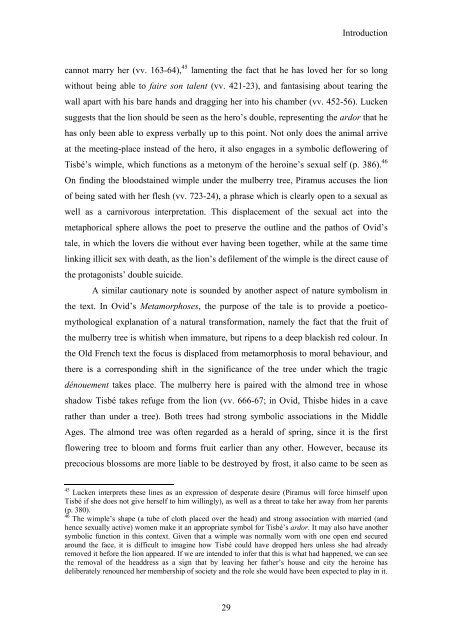You also want an ePaper? Increase the reach of your titles
YUMPU automatically turns print PDFs into web optimized ePapers that Google loves.
Introduction<br />
cannot marry her (vv. 163-64), 45 lamenting the fact that he has loved her for so long<br />
without being able to faire son talent (vv. 421-23), and fantasising about tearing the<br />
wall apart with his bare hands and dragging her into his chamber (vv. 452-56). Lucken<br />
suggests that the lion should be seen as the hero’s double, representing the ardor that he<br />
has only been able to express verbally up to this point. Not only does the animal arrive<br />
at the meeting-place instead of the hero, it also engages in a symbolic deflowering of<br />
Tisbé’s wimple, which functions as a metonym of the heroine’s sexual self (p. 386). 46<br />
On finding the bloodstained wimple under the mulberry tree, Piramus accuses the lion<br />
of being sated with her flesh (vv. 723-24), a phrase which is clearly open to a sexual as<br />
well as a carnivorous interpretation. This displacement of the sexual act into the<br />
metaphorical sphere allows the poet to preserve the outline and the pathos of Ovid’s<br />
tale, in which the lovers die without ever having been together, while at the same time<br />
linking illicit sex with death, as the lion’s defilement of the wimple is the direct cause of<br />
the protagonists’ double suicide.<br />
A similar cautionary note is sounded by another aspect of nature symbolism in<br />
the text. In Ovid’s Metamorphoses, the purpose of the tale is to provide a poeticomythological<br />
explanation of a natural transformation, namely the fact that the fruit of<br />
the mulberry tree is whitish when immature, but ripens to a deep blackish red colour. In<br />
the Old French text the focus is displaced from metamorphosis to moral behaviour, and<br />
there is a corresponding shift in the significance of the tree under which the tragic<br />
dénouement takes place. The mulberry here is paired with the almond tree in whose<br />
shadow Tisbé takes refuge from the lion (vv. 666-67; in Ovid, Thisbe hides in a cave<br />
rather than under a tree). Both trees had strong symbolic associations in the Middle<br />
Ages. The almond tree was often regarded as a herald of spring, since it is the first<br />
flowering tree to bloom and forms fruit earlier than any other. However, because its<br />
precocious blossoms are more liable to be destroyed by frost, it also came to be seen as<br />
45 Lucken interprets these lines as an expression of desperate desire (Piramus will force himself upon<br />
Tisbé if she does not give herself to him willingly), as well as a threat to take her away from her parents<br />
(p. 380).<br />
46 The wimple’s shape (a tube of cloth placed over the head) and strong association with married (and<br />
hence sexually active) women make it an appropriate symbol for Tisbé’s ardor. It may also have another<br />
symbolic function in this context. Given that a wimple was normally worn with one open end secured<br />
around the face, it is difficult to imagine how Tisbé could have dropped hers unless she had already<br />
removed it before the lion appeared. If we are intended to infer that this is what had happened, we can see<br />
the removal of the headdress as a sign that by leaving her father’s house and city the heroine has<br />
deliberately renounced her membership of society and the role she would have been expected to play in it.<br />
29
















